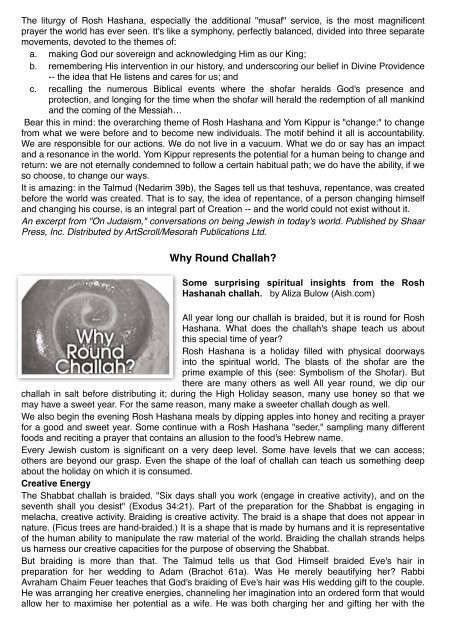ShalomMag HHD 2012 - Loughton Synagogue
ShalomMag HHD 2012 - Loughton Synagogue
ShalomMag HHD 2012 - Loughton Synagogue
Create successful ePaper yourself
Turn your PDF publications into a flip-book with our unique Google optimized e-Paper software.
The liturgy of Rosh Hashana, especially the additional "musaf" service, is the most magnificent<br />
prayer the world has ever seen. It's like a symphony, perfectly balanced, divided into three separate<br />
movements, devoted to the themes of:<br />
a. making God our sovereign and acknowledging Him as our King;<br />
b. remembering His intervention in our history, and underscoring our belief in Divine Providence<br />
-- the idea that He listens and cares for us; and<br />
c. recalling the numerous Biblical events where the shofar heralds God's presence and<br />
protection, and longing for the time when the shofar will herald the redemption of all mankind<br />
and the coming of the Messiah…<br />
Bear this in mind: the overarching theme of Rosh Hashana and Yom Kippur is "change:" to change<br />
from what we were before and to become new individuals. The motif behind it all is accountability.<br />
We are responsible for our actions. We do not live in a vacuum. What we do or say has an impact<br />
and a resonance in the world. Yom Kippur represents the potential for a human being to change and<br />
return: we are not eternally condemned to follow a certain habitual path; we do have the ability, if we<br />
so choose, to change our ways.<br />
It is amazing: in the Talmud (Nedarim 39b), the Sages tell us that teshuva, repentance, was created<br />
before the world was created. That is to say, the idea of repentance, of a person changing himself<br />
and changing his course, is an integral part of Creation -- and the world could not exist without it.<br />
An excerpt from "On Judaism," conversations on being Jewish in today's world. Published by Shaar<br />
Press, Inc. Distributed by ArtScroll/Mesorah Publications Ltd.<br />
Why Round Challah?<br />
Some surprising spiritual insights from the Rosh<br />
Hashanah challah. by Aliza Bulow (Aish.com)<br />
All year long our challah is braided, but it is round for Rosh<br />
Hashana. What does the challah's shape teach us about<br />
this special time of year?<br />
Rosh Hashana is a holiday filled with physical doorways<br />
into the spiritual world. The blasts of the shofar are the<br />
prime example of this (see: Symbolism of the Shofar). But<br />
there are many others as well All year round, we dip our<br />
challah in salt before distributing it; during the High Holiday season, many use honey so that we<br />
may have a sweet year. For the same reason, many make a sweeter challah dough as well.<br />
We also begin the evening Rosh Hashana meals by dipping apples into honey and reciting a prayer<br />
for a good and sweet year. Some continue with a Rosh Hashana "seder," sampling many different<br />
foods and reciting a prayer that contains an allusion to the food's Hebrew name.<br />
Every Jewish custom is significant on a very deep level. Some have levels that we can access;<br />
others are beyond our grasp. Even the shape of the loaf of challah can teach us something deep<br />
about the holiday on which it is consumed.<br />
Creative Energy<br />
The Shabbat challah is braided. "Six days shall you work (engage in creative activity), and on the<br />
seventh shall you desist" (Exodus 34:21). Part of the preparation for the Shabbat is engaging in<br />
melacha, creative activity. Braiding is creative activity. The braid is a shape that does not appear in<br />
nature. (Ficus trees are hand-braided.) It is a shape that is made by humans and it is representative<br />
of the human ability to manipulate the raw material of the world. Braiding the challah strands helps<br />
us harness our creative capacities for the purpose of observing the Shabbat.<br />
But braiding is more than that. The Talmud tells us that God Himself braided Eve's hair in<br />
preparation for her wedding to Adam (Brachot 61a). Was He merely beautifying her? Rabbi<br />
Avraham Chaim Feuer teaches that God's braiding of Eve's hair was His wedding gift to the couple.<br />
He was arranging her creative energies, channeling her imagination into an ordered form that would<br />
allow her to maximise her potential as a wife. He was both charging her and gifting her with the


